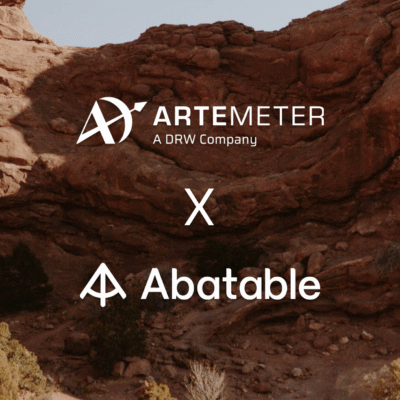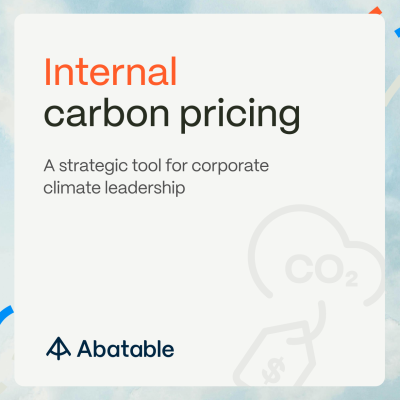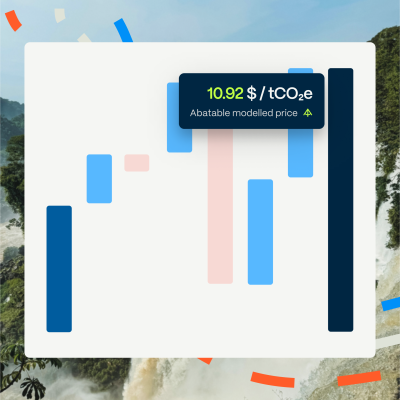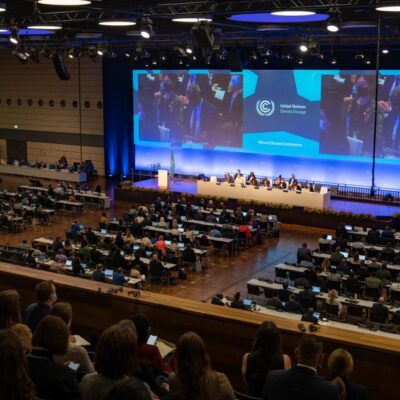Abatable’s inaugural VCM Investment Attractiveness Index highlights the abundant opportunities for investment in voluntary carbon market projects across a wide range of countries. With Article 6 of the Paris Agreement set to determine the future direction of carbon markets, how countries interact with it will have a large bearing on their Index ranking in the coming years.
Despite the recent market turbulence, whichever forecast you look at the voluntary carbon market (VCM) is set for substantial growth over the coming decades.
BCG and Shell valued the market at $2bn annually at the start of the year and projected it would reach between $10bn and $40bn by 2030. More recently, following the drop in carbon credit prices seen since January, Barclays estimated the VCM was worth $500mn today but said it could grow substantially to $250bn a year by 2030 and $1.5tn a year by 2050.
This forecasted growth is good for climate action. If we are to meet our climate targets, the growing emissions gap between our current global CO2 output and where we need to be to keep warming at 1.5C needs to close. Climate finance will be critical in making this happen. Carbon-sequestering ecosystems need protecting – investment channelled through the VCM into high-quality carbon projects can play a fundamental role in enabling this.
It is in this context that Abatable launched the VCM Investment Attractiveness Index, to help investors identify the most promising countries in which to support carbon projects and to highlight to policymakers steps that can be taken to improve the attractiveness of their countries for carbon market investment. The Index can be used to track the effectiveness of policies over time by comparing certain market indicators before and after policy interventions.
The Index has launched at a critical time for the VCM, ahead of the COP28 climate summit which will see further progress towards a framework for the Paris Agreement’s Article 6.
The Index, which was developed in collaboration with global insurance group Howden, scores countries across a series of indicators clustered into three main pillars:
- Global carbon market readiness, analysing the jurisdiction’s experience in hosting VCM projects and its readiness to manage its engagement with Article 6 of the Paris Agreement;
- Investment landscape, providing insights into the national political and economic context as a measure of the risks for foreign investors; and
- Climate, nature and people opportunity, quantifying the potential impact of the role the VCM can play in closing the financing gap to reduce emissions, conserve critical ecosystems and improve livelihoods.
The full Index methodology can be found here.
Who’s where, and why?
Kenya, Mexico and Peru lead the Index this year as the three frontrunner countries for VCM investment and project development.
The countries share some characteristics, particularly in the global carbon market readiness pillar which has a strong bearing on the overall ranking. All three nations have mature carbon project developer ecosystems formed through a long history in the VCM, as well as a good supply of credit types that are in demand in the market today. They have all shown early initial engagement with Article 6.
There are big opportunities to improve access to clean cooking technologies and to increase the share of renewables across all three nations. Each country is home to a large number of endangered species, so there is potential for the VCM to help conserve habitats for these animals.
Deeper dives
Kenya – Africa’s VCM leader
Index rank number: 1
Overall Index score: 78.03
Global carbon market readiness score: 89
Investment landscape score: 66
Climate, nature and people opportunity score: 72
A country full of lowland and mountain forests, grasslands and wetlands, boasting a long VCM history and a favourable supply of in-demand credits, Kenya tops the VCM Investment Attractiveness Index for 2023. Its top placement is also due to the significant potential to enhance clean cooking accessibility in rural regions as well as the country’s mature carbon project developer ecosystem, which includes Africa’s first direct air capture company.
At the time the Index was launched, the Kenyan government’s Climate Change (Amendment) Bill 2023 had just been signed into law by Kenya’s President William Ruto. The Bill, which will stand Kenya in good stead for Article 6, has a focus on carbon markets and will see the country establish a national carbon registry run by a designated national authority.
The Bill also sees Kenya become one of the first countries to set rules for carbon project benefit sharing – 40% of profits from land-based projects, and 25% from water-based, will go to host communities. This and the provision for carbon project developers to specify the environmental, economic and social benefits they anticipate will help provide certainty and boost integrity in the market.
In June 2023 Kenya signed a Letter of Intent to supply high-integrity emissions reductions and removals credits to the LEAF Coalition to enhance its jurisdictional REDD+ (Reducing emissions from deforestation and forest degradation in developing countries) programme. In the same month it hosted what was billed as the largest carbon credits auction of its kind, which saw strong demand from Saudi Arabian companies including Aramco and Saudi Electricity Company.
To keep its Index high score it is now important for Kenya to allocate adequate resources to successfully implement its amended climate change Bill. Alongside its forthcoming registry, Kenya will need to develop an authorisation process as well as a mechanism to track “corresponding adjustments”. This is the Article 6 mechanism to avoid double counting tonnes of CO2 abated across borders.
Elsewhere in Africa there are other nations with strong VCM credentials. The Index top 10 also includes Ghana (fourth place), Malawi (fifth place) and Ethiopia (sixth place), which have outstanding global carbon market readiness scores due to their historical engagement with the VCM and Clean Development Mechanism (CDM), and recent engagement with Article 6 via pilot projects and bilateral agreements. Ghana really stands out for the number of Article 6 pilot projects already ongoing.
Mexico – a megadiverse market
Index rank number: 2
Overall Index score: 78
Global carbon market readiness score: 88
Investment landscape score: 64
Climate, nature and people opportunity score: 76
Mexico, one of the world’s “megadiverse” countries in terms of its biodiversity, comes just after Kenya in the Index ranking. Mexico is in a good place to capitalise on new global carbon market opportunities given its legacy of engaging in international climate policy and carbon markets, however its REDD+ experience score in the Index is below that of Kenya’s.
There is a large opportunity to reverse the current downward trend of rainforest and terrestrial ecosystem loss in Mexico, which is reflected in the country’s high scores in the Opportunity to reduce deforestation and Biodiversity conservation potential indicators in the Index.
The Mexican federal and state governments have demonstrated a favourable stance towards VCM projects by integrating carbon credits from the VCM as flexibility mechanisms under the country’s emissions trading scheme. Carbon credits can also be retired against state-level carbon tax regimes.
Upcoming carbon market regulation is likely to add a national credit registry and provide for greater integration of the VCM within Mexico’s broader climate plans, as well as introduce greater social safeguards.
In terms of future actions, Mexico could move to define carbon rights beyond nature-based solutions and can improve its Index score by engaging more with Article 6.
Peru – REDD+ pioneer
Index rank number: 3
Overall Index score: 73.74
Global carbon market readiness score: 81
Investment landscape score: 47
Climate, nature and people opportunity score: 85
Peru, a leader in the VCM – particularly in regard to REDD+ and nature-based solutions to conserve its tropical rainforests – places third in the Index. The Peruvian government recognises the VCM as a key source of international climate finance and is working to integrate VCM architecture into its jurisdictional-level activity.
Peru has developed a national registry of mitigation measures, RENAMI, which means its carbon market infrastructure is more advanced than many other countries and this sets it up well in terms of preparedness for Article 6. The registry will see VCM units able to be used with corresponding adjustments under Article 6, meaning they will count against any purchasing country’s nationally determined contribution (NDC), and Peru is among the first countries to signal that it will be taking this approach.
In this regard Peru has already signed agreements with other nations for the transfer of carbon credits. In 2020 it signed a carbon credit agreement with Switzerland, considered the world’s first carbon offset deal under Article 6. Projects designed to contribute to sustainable development in Peru will be financed by Switzerland and the emissions reductions will count towards its NDC. Peru has also signed a Memorandum of Understanding with Singapore to develop a bilateral trading agreement under Article 6.
More generally, there are opportunities for Peru to improve clarity on how the VCM will interplay with Article 6 and its NDC, as well as to extend carbon rights legislation beyond nature-based carbon rights. Delays to registry implementation can also be improved to reduce some uncertainty in the market.
We provide additional insights on these and further countries in our national policy profiles of our market intelligence platform.
Index insights
There are a number of common trends when viewing all countries’ Index performance.
The first is that a country’s REDD+ legacy is a strong reflector of its institutional capacity and capabilities when it comes to the VCM.
There is good correlation between REDD+ experience and a country’s understanding and mastery of the market. Countries that have extensively engaged with REDD+ are ahead of the game today with carbon market foundations like defining carbon rights and setting up registries and safeguard mechanisms. This results in a high level of understanding of how these markets function and as a result a strong basis on which to become sellers of Article 6-aligned credits.
The second is that historical engagement with the CDM may actually in some cases be associated with a lower placing in Index rankings. A high CDM score often corresponds with a lower score in other more heavily weighted indicators in the Index which have more of a bearing on rank.
This is due to inertia from setting up capacity and infrastructure for CDM-friendly credit types such as renewable energy and industrial efficiency credits, which are no longer in demand from the market. These solutions are now largely able to operate without additional finance from the VCM in many markets due to their technological maturity.
The third is that the Index highlights many attractive countries in the top 40 that have historically been overlooked for VCM investment. The VCM has considerable potential to aid development in these countries.
However, most countries in the Index top 10, while ranking highly in the climate, nature and people opportunity and global carbon market readiness pillars, score between 50 and 60 in the investment landscape pillar. Thus, investors that want to make a significant impact from a climate, social and nature point of view need to be ready to take on some risk.
Finally, how countries continue to push engagement with Article 6 will have a large influence on how the ranking will change in the future. With this, there is a certain element of being dependent on what happens on the international stage. COP28 is a critical juncture in the development of Article 6. Decisions made will determine the pace to which carbon markets move towards full Article 6 adoption, and the role the VCM – as it exists today – plays in this.
Today, experienced investors tend to place more value on the preparedness of a country to engage with a global carbon market than what the general investment landscape of a country looks like – seeing this as conducive to a better enabling environment for investment. The outstanding question is: Are institutional investors ready to take on the level of political risk needed to support these countries that have so much VCM potential?
For more information, or to find out more about Abatable’s detailed national carbon market policy assessments, email [email protected]














































































































